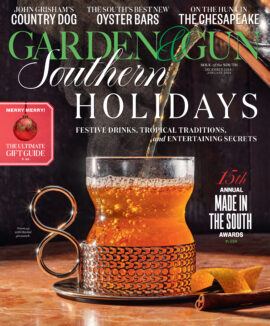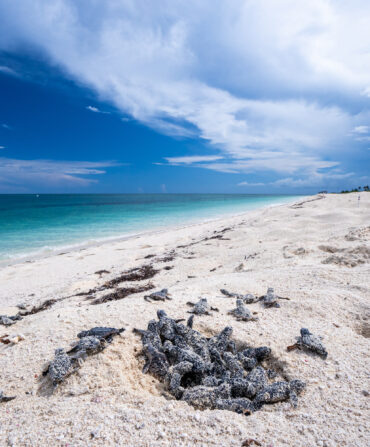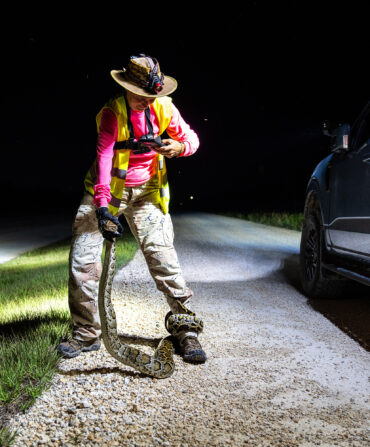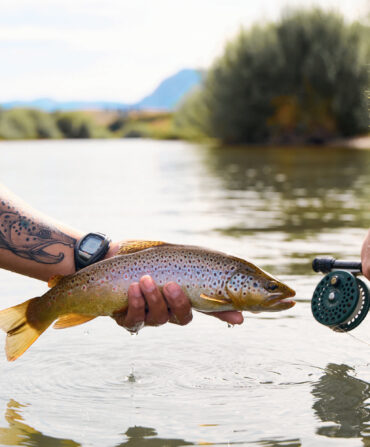Sporting
The Best Fishing Guide Alive
Steve Huff has spent a lifetime putting clients on the fish of their dreams. And he’s not stopping anytime soon
It’s early morning in Chokoloskee, Florida, and Steve Huff is slowly guiding us away from the dock. The bow of his Hell’s Bay skiff is pointed toward the labyrinth of mangroves and buttonwoods that give shape to the mesmeric Everglades, where Huff spends nearly two hundred days a year. He’s wearing a bandanna that’s patterned with fish scales. It covers his sunburned nose and trimmed cotton-white mustache. His long arms dangle from a wiry, compact body that seems almost simian in its alertness and strength.
Then he guns the engine. As the boat planes quickly and easily, Huff lifts up his bandanna, revealing a wide smile.
“Do you feel that?” he yells to me over the engine’s whine. “We’re free.”

Photo: Matthew Hranek
Steve Huff is sixty-five. He has been a fishing guide for forty-three of those years, first in the Florida Keys and now in the Everglades City area, where he moved in 1996 with his bright-eyed wife, Patty. Huff’s specialty is fishing the skinny saltwater flats for tarpon, bonefish, permit, and snook, and he has guided his clients into countless world-record fish. Last year he was inducted into the International Game Fish Association’s Hall of Fame, which is the fishing world’s Cooperstown. In his book, A Passion for Tarpon, Andy Mill calls Huff “bar none, the best tarpon guide alive, the best there was and the best there ever will be.” Marshall Cutchin, a former Keys guide and the editor and publisher of the fly fishing website midcurrent.com, goes even further, calling him “the best guide who’s ever lived, period.”
This type of talk embarrasses Huff, who prefers to shower accolades on others. “Steve is a really humble guy,” says Sandy Moret, who owns a fly shop in the Keys and has fished with Huff for three decades. For Huff, it’s all pretty simple. “I’m just a fishing guide,” he says. “My job is to make an angler’s dream come true.”
His own dreams are part of the equation, as well. Guiding, at its essence, is a selfless endeavor, geared to the happiness and success of the paying customer, the “dream making.” But for Huff, there is the rush—of being on the water nearly every day and trying to figure out the puzzle presented by the tides, the wind, the clouds, the fish, and the angler’s ability. The climax, that final puzzle piece, is the hooking and landing of the guided angler’s targeted fish. Huff can’t live without that rush.
Huff was born and raised in Miami. When he was ten, his father gave him a spinning rod, the first piece of tackle he’d ever owned. His father left the next day. Huff would neither see nor speak to him again. “He was an alcoholic and a gambler,” Huff says. “He probably died in a ditch somewhere.”
Huff is unsentimental about the impact that his father’s leaving might have had on his life. “I think we grow up to be whatever we were meant to be,” he says. And anyway, with that fishing rod, his father provided him with the first tool for what would become his life’s abiding passion. Huff took the rod, cast into a Miami canal, and caught a two-pound snook. “That was it,” he says. “I was done.” He biked all over the city, fishing in backyards and canals. One day he sneaked down a manhole in the middle of a causeway bridge. He cast a lure from a ladder and caught a twenty-seven-pound snook, to this day his largest. He knew then that he would be a guide someday.
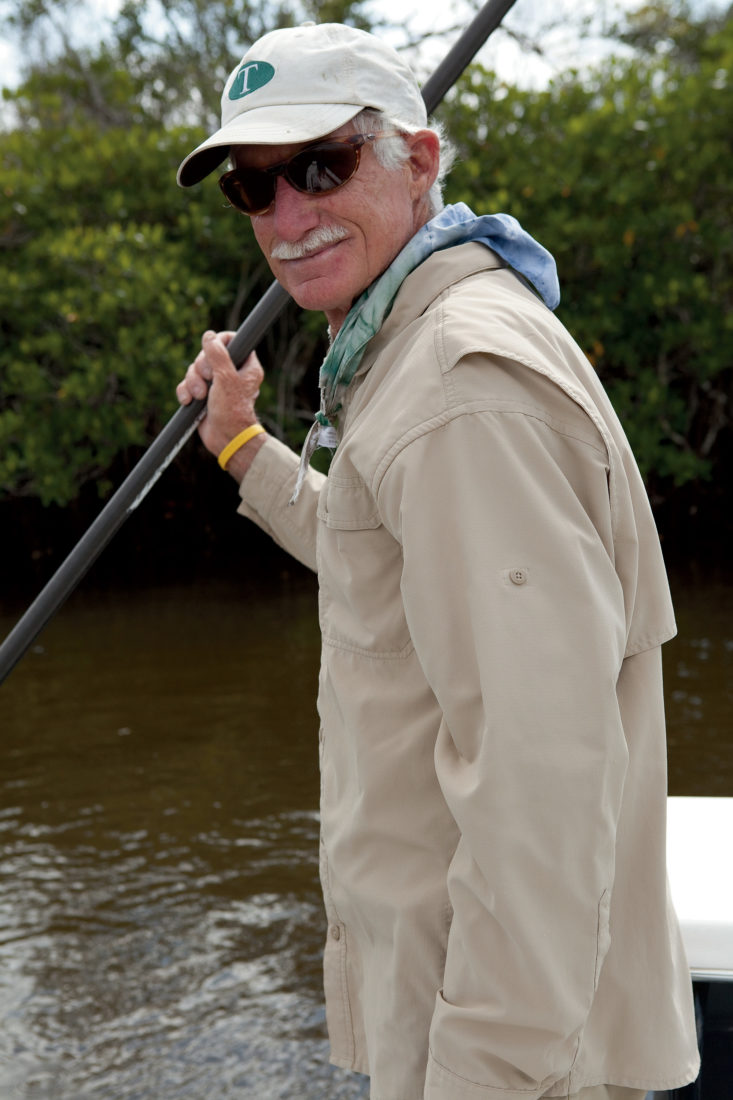
Photo: Matthew Hranek
The Silver King
On the water in the Everglades.
While attending the University of Miami, Huff studied marine biology. When he graduated, he told his mother of his career plans. She was not pleased. “She told me that fishing guides were a bunch of drunks and bums and that I would never amount to anything,” Huff says.
Still, she cosigned a bank loan so Huff could buy his first guide boat. He moved to the Keys, and on November 1, 1968, he took out his first client. “Poor bastard,” Huff says. The day was windy and overcast and fishless. The guy never came back. “I had no clue what I was doing,” Huff says. “I didn’t even know what I didn’t know.”
But Huff was determined to figure it out. He poled for miles, into the teeth of twenty-five-knot headwinds. (“Best poler I’ve ever seen,” Cutchin says.) He scouted and discovered new spots. He tied his own flies, designed his own boats, invented new fishing knots. He stayed out longer than anyone else, making the run back to the dock in complete darkness. He never gave up.
And within a few years, people who fished with him once never wanted to leave him. “He’s intense and he expects you to match that intensity,” says one of his clients, the author Carl Hiaasen. “It makes you a better angler.” Bill Hassett, a sporting goods store owner in St. Louis, Missouri, has fished with Huff for thirty-seven consecutive years. Lenny Berg, an ophthalmologist in Fort Pierce, Florida, has been with him for thirty-five years. Hiaasen is a relative newcomer, having fished with Huff for fifteen years. “I just feel fortunate that he let me on his boat,” Hiaasen says, laughing.
Those who do fish with him tend to get greedy. The late Del Brown once booked Huff for fifty-five days one year to fish for permit in the Keys. Tom Evans, holder of sixteen world records, once locked him in from March 1 to June 15. Huff now has a list of about fifteen clients, to whom he is intensely loyal (he turned down a trip with George H. W. Bush in favor of one of his already-booked regulars). He has taken on exactly one new client in the last twenty years.
His clients have become his closest friends. “When you’re in a small boat together for ten to twelve hours a day, you quickly get past the small talk,” Huff says. “You laugh and you cry together.” One client constantly complained about his wife for years. Hoping to change the subject on the water one day, Huff bluntly told him he should divorce her. The man called back a week later and told Huff that he had filed divorce papers. “I said, ‘You’ve got to be shitting me,’” Huff says.
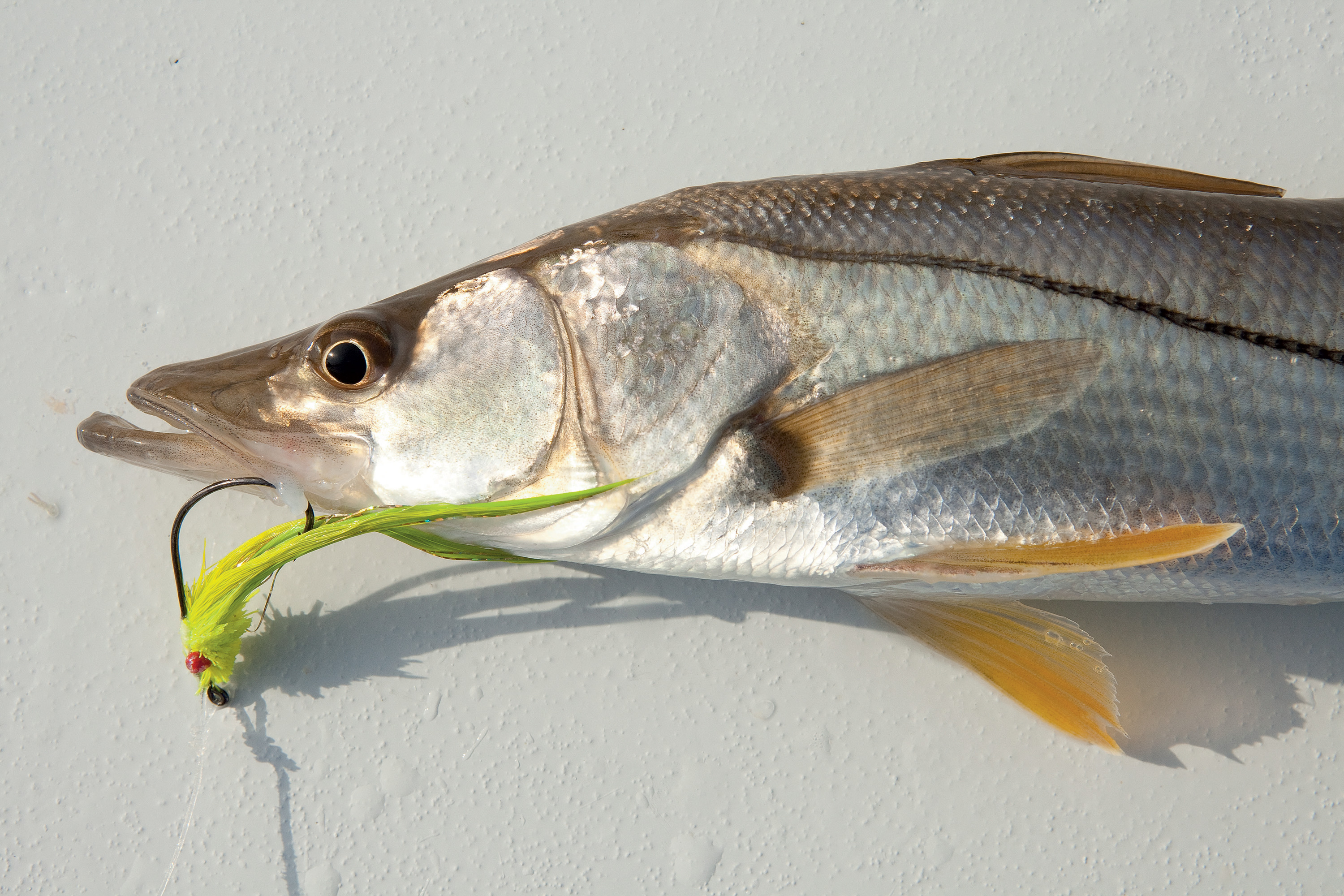
Photo: Matthew Hranek
A snook.
As with all intense relationships, complications can arise. Huff no longer fishes with one of his longest-tenured clients. “One day I just told him what he was: a selfish prick,” Huff says. The guy asked Huff why it took him so long to figure that out. To this day, the two still talk on the phone a few times a year, unable to completely disconnect. One of the saddest endings came with Del Brown, who posthumously still holds twelve world records. Huff and Brown had fished together since 1980. They were a perfect pair on the water, with matching intensity and drive. But one late afternoon in 2001, when Brown was eighty-three, Huff poled for an hour into the wind to get Brown in position to fish. Huff waited for Brown to hold up his end of the bargain and cast for a fish. But Brown put his rod down and told Huff he wanted to go in. Huff was wracked with heaving sobs as he ran the boat in. At the dock, he told Brown through tears that he could not fish with him anymore. “It was really my problem,” Huff says. “Del was getting older and I just didn’t want to admit it. It broke my heart.” Brown died two years later.
Huff has witnessed many strange moments during his forty-three years on the water. An unhooked 100-pound tarpon once leaped into his boat and hit a female client squarely in the chest. (On his boat the next year, she wore a flak jacket as a gag.) One year he was fishing with Tom Evans when Evans suddenly had to use the bathroom. As Evans hung off the back of the boat, he asked Huff to cast for a rolling tarpon. Huff did, and he hooked and landed a 186-pound tarpon, which would have been the world record. But Huff never submitted it to the IGFA. “Tom wanted that record so badly,” he says. A week later, Huff led Evans into a 177-pounder, which indeed did become the world record.
But perhaps the strangest thing happened with a man named Everett Watkins, who flew from California to fish with a friend who had set up a trip with Huff. Watkins, an obese man, hooked a 125-pound tarpon on one of his first casts. But he played the fish very slowly, as if he were in a trance. “I told him he needed to bear down on the fish because there are only two things that could happen: He would land the fish or he would lose it,” says Huff. “Little did I know there was actually a third scenario.”
With the fish still on his line, Watkins suddenly collapsed face-first onto the bow. Huff broke off the fish and ran back to the dock at full speed. “He was blue when they loaded him onto the ambulance,” Huff says. It turned out that Watkins had an aortic aneurysm and was dead before he hit the deck. “I felt really bad and I asked his buddy what we should do,” Huff says. “He told me Everett would have wanted us to go back and fish. So we did. And we caught two nice tarpon.” The incident spawned more than a few bad jokes. “People said, ‘Damn, Steve, folks really are dying to fish with you,’ and ‘Why did you break the fish off?’” Huff says. He now takes an angler back to the dock at the first sign of physical distress.

Photo: Courtesy of Florida Keys Outfitters Archives
Huff with his fly-caught 186-pound tarpon in 1977.
Luckily, I feel pretty good on this overcast and cool morning as Huff and I make a thirty-minute run into the heart of what Peter Matthiessen called “shadow country”—the vast sky, knotty mangroves, and moving water that are the Everglades.
Huff cuts the engine and hops up on his poling platform. He’s wearing a khaki-colored shirt and pants and a pair of closed-toed Crocs. He propels the boat forward with seemingly little effort with his twenty-one-foot pole. We’re after snook, the fish that has remained Huff’s favorite since his childhood days in Miami.
I stand in the bow and cast a yellow streamer that Huff devised. (“It doesn’t have a name. It’s just deer hair and chicken feathers,” he says.) The wind from an incoming storm is brisk but not unbearable. I’m not exactly throwing strikes with every cast. I start to press a bit, and the casts get even worse. Huff gives me an essential pointer: “Just hold your back cast a bit longer,” he says. I quickly see positive results. Huff poles us along, fifty feet or so from the bank. Almost immediately, I start getting solid takes, and within an hour I’ve landed five smallish (two- to four-pound) snook.
“If you do everything right—cast and manipulate the fly—they will reward you and eat it,” Huff says. Permit, on the other hand, are a dishonest fish. “You can do everything exactly right and they will still screw you,”
I ask Huff if he thinks different fish have different personalities. “They sure do,” he replies. Tarpon, he says, seem almost human because they’re so big. “You can see their actual gestures and can tell if they are happy or agitated. I’ve actually seen them yawn and stretch. It’s hilarious.” Fishing for them, he adds, “is like heroin.”
Bonefish are the most honest fish. “If you do everything right—cast and manipulate the fly—they will reward you and eat it,” Huff says. Permit, on the other hand, are a dishonest fish. “You can do everything exactly right and they will still screw you,” he says. Snook “are pickpockets. They are sinister. They’re always around, but you rarely see them. Then they sneak up on you and strike the fly so savagely.”
Huff has also made a case study on the nature of anglers. He’s seen men who can cast a country mile and land the fly on a dime but who couldn’t catch a fish in an aquarium. He’s seen others who have ugly casts and manage to catch everything they see. “Some people just have a fish sense,” Huff says. “I don’t care what someone’s cast looks like. I’d rather have a person who has some sense of where the fly should be and how to manipulate it and talk the fish to the fly.” I’m hoping that with the imperfect casts I’m tossing, I fall into the latter category.
Huff and I talk about our families (he has three grown children) and relationships (Patty, to whom he’s been married for twenty-six years, is his second wife; they met through her father, who was a client of Huff’s). Huff is a voracious reader and likes to discuss books. But as he talks, I notice that he’s constantly eyeing the water in front of us and beyond, looking for any signs of fish. I follow his lead and start to shift into deep concentration between conversations.
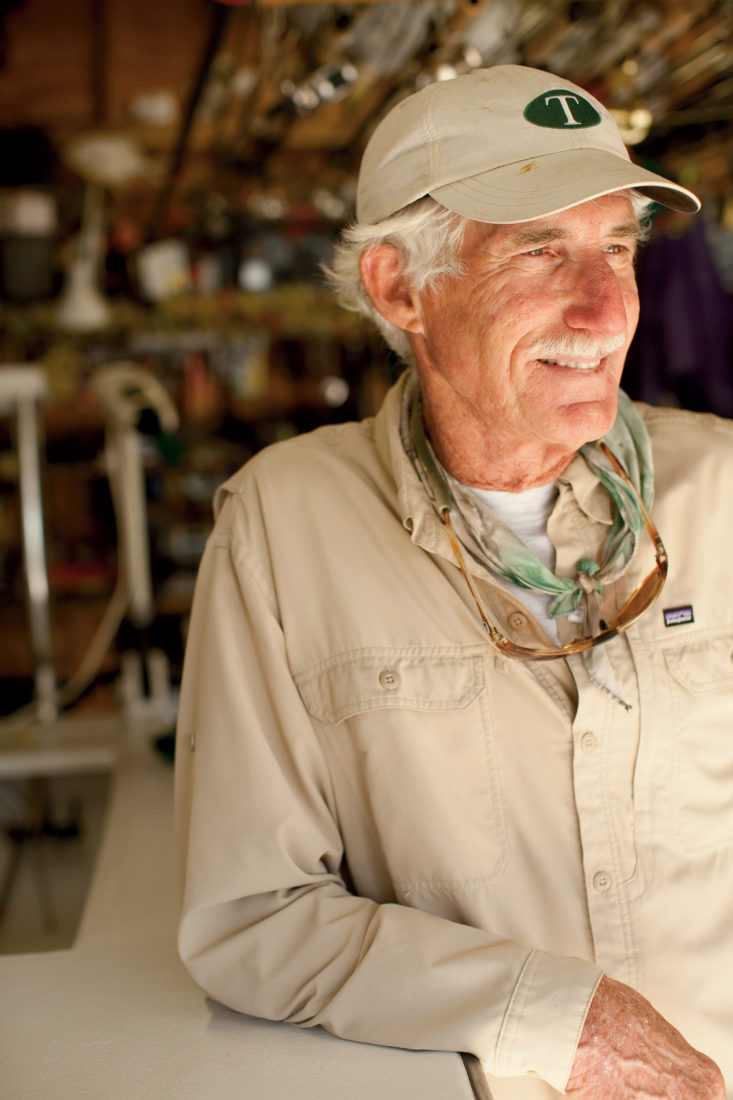
Photo: Matthew Hranek
Born to Fish
Steve Huff in a rare relaxed moment at his home in Everglades City.
Huff sees a dark mangrove stump in the water near the shore. “Cast right around that,” he says. “I think I see something.” I cast, make two strips, then my fly is brutally attacked. Water sprays three feet into the air. It’s a snook. As it heads for the mangroves, Huff calmly tells me to tighten up on him a bit. After another strong run, I get the snook near the boat and start to bend down in preparation for landing it. “Just wait,” Huff says. “He’s got one more good run in him.” Sure enough, the snook takes off, burning line through my fingers. When I finally get him to the boat, he weighs in at eight pounds, my biggest snook ever.
We motor to another shoreline. Just as Huff starts poling, he points to a spot a few feet from the bank. “See that shadow?” he asks. “That’s a good one.” I miss the intended spot (a few feet from the fish’s nose) by a good margin. The fish responds anyway, slowly stalking the fly. “That’s a fifteen-pounder,” Huff whispers. I try to tease the fish with the fly, but I’m running out of room. Five feet away, the fish shoots off, spooked. Only later will I learn what a true trophy a fifteen-pound snook is on a fly.
After a half dozen more snook, we head in. The wind has picked up, whitecapping the water. Huff would normally stay out, but I have to catch a plane. I feel honored to have shared a day with Huff. He makes me feel like the honor was all his.
Guiding is an incredibly taxing vocation, on both mind and body, and especially for saltwater flats guides, who may push a boat manually with a pole for up to ten hours a day. Most guides, like NFL running backs, last three to four years. In his younger days, Huff once went five straight months on the water without a break. The physical toll of his guiding is visible only on his hands. His fingernails are gnarled and scratched white. His puffy palms are covered with nicks and cuts. The backs of his hands are speckled with liver spots.
Huff still maintains the pace of men a third of his age. But by his own standards, he has slowed down, if only a bit. Now he takes weekends off to spend more time with Patty, who is the editor and publisher of the Everglades City paper, the Mullet Rapper. But he is rarely idle. He doesn’t own a computer. (“It’s appalling to me that people spend a beautiful day indoors staring at a glass screen,” he says.) He runs nine miles every Saturday. He’s become an avid bicyclist. A few years back, he and Patty rode their bikes from their house in Florida to Astoria, Oregon. Then they rode back.
But even with the biking and running, Huff can’t spend more than a few days away from the water. His passion is bringing people into his world of mangroves and tides and fish and the fulfillment of dreams.
“I love what I do,” he says.

